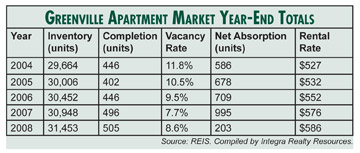|
SOUTHEAST SNAPSHOT, JUNE 2009
Greenville Multifamily Market
The Greenville multifamily market is taking its cues from commercial real estate sectors throughout the Southeast. Though Greenville is a smaller market and thus does not have the same volume of problems as larger cities, apartment brokers are still seeing signs of the recession.
“Greenville is pretty much mirroring the nation right now, with increased vacancies and the related increase in concessions,” says Michael Dodds of Integra Realty Resources. He adds that the vacancy rate sits at 10.1 percent, which is an increase of 270 basis points since the first quarter of last year. Most of this increase occurred during the fourth quarter of 2008 and the first quarter of 2009.

A flight to cheaper properties is further fueling the vacancy increase. Instead of taking advantage of lower rates at their existing properties, owners are moving to lower-grade complexes, hoping to save money.
“Owners are scrambling to deal with the increased concessions that renters are demanding,” he says. “We are seeing some tenants from Class A developments making the move to B+ product to take advantage of the reduction in rent and minimal change in quality of life.”
Dodds is the owner of Greenville Property Pulse, a market research firm that takes the temperature of the area’s commerical real estate market. Recently, the company completed a survey of multifamily sales from 2006 to 2008. Dodds found that there was a 57.6 percent decline in multifamily sales from 2007 to 2008.
“That was the highest of all property types analyzed in the study,” he says. “There were 3 months in 2008 that recorded no apartment sales at all. That was the only time it happened in the 3-year analysis period.” He adds that the last substantive transaction — a 116-unit complex that sold for $39,000 per unit — occured in November.
The vacancy rate has led to an overall lack of demand for new apartment buildings. In addition to these weak construction prospects, some developers have been encountering other problems. Instead of simply planning a development and breaking ground, officials are meeting resistance from the community, especially in prime locations like the Woodruff Road corridor. “The Woodruff Road corridor is a desirable area, but the locals have been effective in protesting new projects,” Dodds says. “Several rezoning requests have been turned down.”
Getting these projects off the ground, even if they were approved and encountered no backlash from the community, would still be an uphill battle. The lending market in Greenville is as sluggish as anywhere else in the country, so the money to build just isn’t available.
“Given the current economic climate and the lack of available credit,” he says, “it is unlikely that any planned projects will break ground until the overall economy improves.”
— Jon Ross
©2009 France Publications, Inc. Duplication
or reproduction of this article not permitted without authorization
from France Publications, Inc. For information on reprints
of this article contact Barbara
Sherer at (630) 554-6054.
|
